A Historical Walk Through Town
Guided Walking Tours
Want to explore Gibraltar by foot? Join one of the verified guides.
Casemates Square
Start outside the Police Station, Casemates Square:
Casemates Square: The site of the original Moorish Water Gate through which the Moors launched their galleys. General Adye opened the second gate in 1884 to provide for the much-increased traffic from the north, which Landport was not wide enough to carry. Landport Gates was the entrance to the town from the North, approached by a drawbridge across the wet ditch; it gave access through the Moorish defence wall from the castle to the Barcina the port area of Moorish and Spanish Gibraltar. The British rebuilt it after the 1727 siege.
Picture the scenario: it is the second half of the fourteenth century. The Battle of the Strait is unfolding. Spurred by the capture of Gibraltar by the Spaniards in 1309, a new Muslim dynasty that has taken over the whole of the Maghreb crosses the Strait and recaptures the Rock. These Merinids control a large territory, northwards to Ronda. To the east Granada is under the control of the Nasrids, to the north-west Christian forces are pushing towards the Strait. These forces are vying for control of the Strait among themselves and with two powerful navies, those of Aragon and Genova. With the fall of Algeciras to the Christians, Gibraltar becomes the main port of the Merinids.
Determined not to let Gibraltar fall once again, the Merinid Emir Adu’l Hassan strengthens Gibraltar. Hassan fortifies the Castle and encircles the town with strong walls. To reduce the threat of attack on his fleet, sheltered in the shallows close to where Casemates is now situated, he builds a Dar-al-Sinaha, a galley house from which the terms arsenal, darsena and atarazana are derived. In the safety of the galley house, encircled by sea walls and under the mighty protection of the castle, Hassan’s fleet strengthened and waged war on the rival navies. For centuries after this Casemates has always been associated with military activity. The Spaniards eventually recovered Gibraltar in 1462 but as shipping evolved, Casemates could no longer house the large galleons. Casemates had by then been turned into a residential district known as La Barcina. Here people lived in single storey houses with flat roofs in the Berber style. They kept cattle and donkeys within confines of the walls and they harvested the marine resources of the shallow bay. La Barcina could not protect the Spanish Galleons and the Spaniards suffered a heavy defeat, prompting the restructuring of the fortifications by Luis Bravo and the move of the harbour facilities towards the new mole in the south.
Casemates thus continued until 1704 when George Rooke captured Gibraltar. The immediate aim of the British was the strengthening of the Rock’s fortifications. The north of Gibraltar was particularly significant because of its proximity to the Spanish lines. The large galley house, with its thick 2.5-metre walls was an ideal building in which to store ammunition. It became the Shot House and stood the onslaught of the thirteenth siege in 1727 at a time when most of the houses of La Barcina were destroyed. The area was so devastated that most of it was levelled in 1713, leaving the shot house, which survived until it was severely damaged and pulled down after the Great Siege. Casemates was to continue to be a military place. At the beginning of the nineteenth century, the barracks were built on the north of the square and the square itself became the training and parade ground for the troops. It continued to be used in this manner into the twentieth century and the square was used for public hangings. At the square, we also find the Koelher Depression Gun Carriage designed by Lt Koelher R.A. during the Great Siege 1779-1783 to enable the defenders to shoot down at the enemy who had come too close to the foot of the defence works.
Finally, today the development of the Casemates Square is a celebration of peace. It is now a place where people of different beliefs and ethnic backgrounds meet in the spirit of conviviality that is so characteristic of Gibraltar.
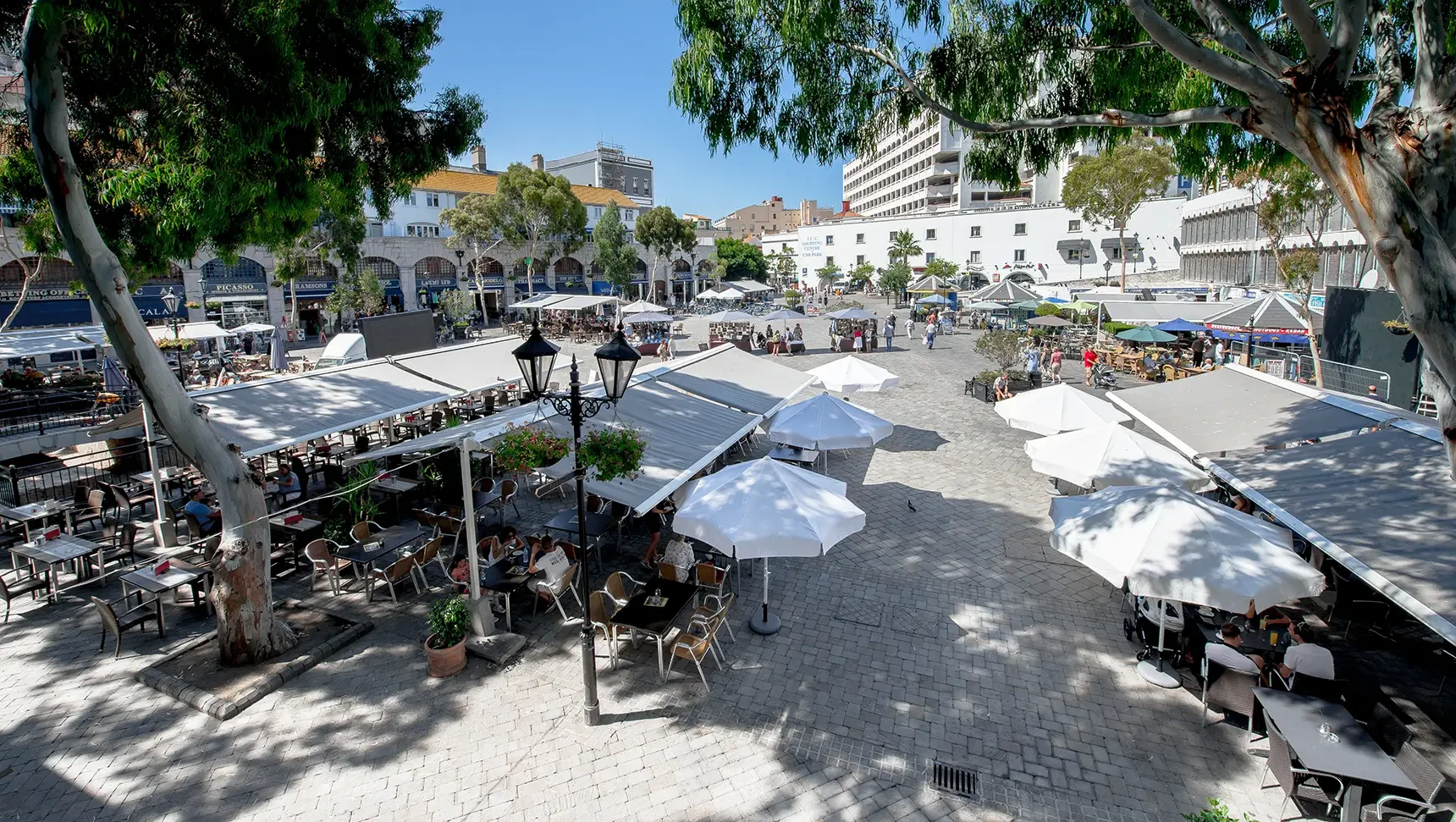
American War Memorial
Walk up the hill at the end of Casemates Square by the taxi stand and cross Line Wall Road at pelican crossing near the American War Memorial.
American War Memorial: The Memorial is a World War I naval monument located near the north end of Line Wall Road. This memorial was incorporated into the Line Wall Curtain and American steps that give pedestrians access to Reclamation Road, Fish Market Lane, Chatham Counterguard and Queensway. The monument was designed by architect Paul Philippe Cret (1876 – 1945), a native of France who was a professor at the University of Pennsylvania. Cret designed the memorial on behalf of the American Battle Monuments Commission. It was constructed between 1932 and 1933. The inscription over the arch of the memorial indicates that it was "erected by the United States of America to commemorate the achievements and comradeship of the American and British Navies in this vicinity during the World War. On the other side of the masonry arch are two bronze medallions depicting the seals of the United States and of its Department of the Navy. The dolomitic limestone utilised in the construction of the monument was sourced in Gibraltar. The memorial is an example of the successful incorporation of a relatively recent work into older, existing architecture.
Memorial plaques at the base of the steps at the monument:
USS Chauncey: Memorial plaque naming persons who perished in the Strait of Gibraltar 1917. The destroyer sailed on 1 August 1917 for convoy escort duty in the eastern Atlantic. On 19 November, some 110 miles west of Gibraltar on escort duty, Chauncey was rammed by the British merchantman SS Rose as both ships steamed in war-imposed darkness.
US Coastguard Tampa: sunk by enemy submarine in Bristol Channel on the 26th day of September 1918. All on board were lost.
Coast Guard Seneca: Vessel lost in endeavouring as volunteers to salvage the torpedoed British Steamer Wellington in the Bay of Biscay in September 1918.
The First US Naval Squadron at Gibraltar: In commemoration of the arrival of the first US Naval Mediterranean squadron at Gibraltar on 1 July 1801.
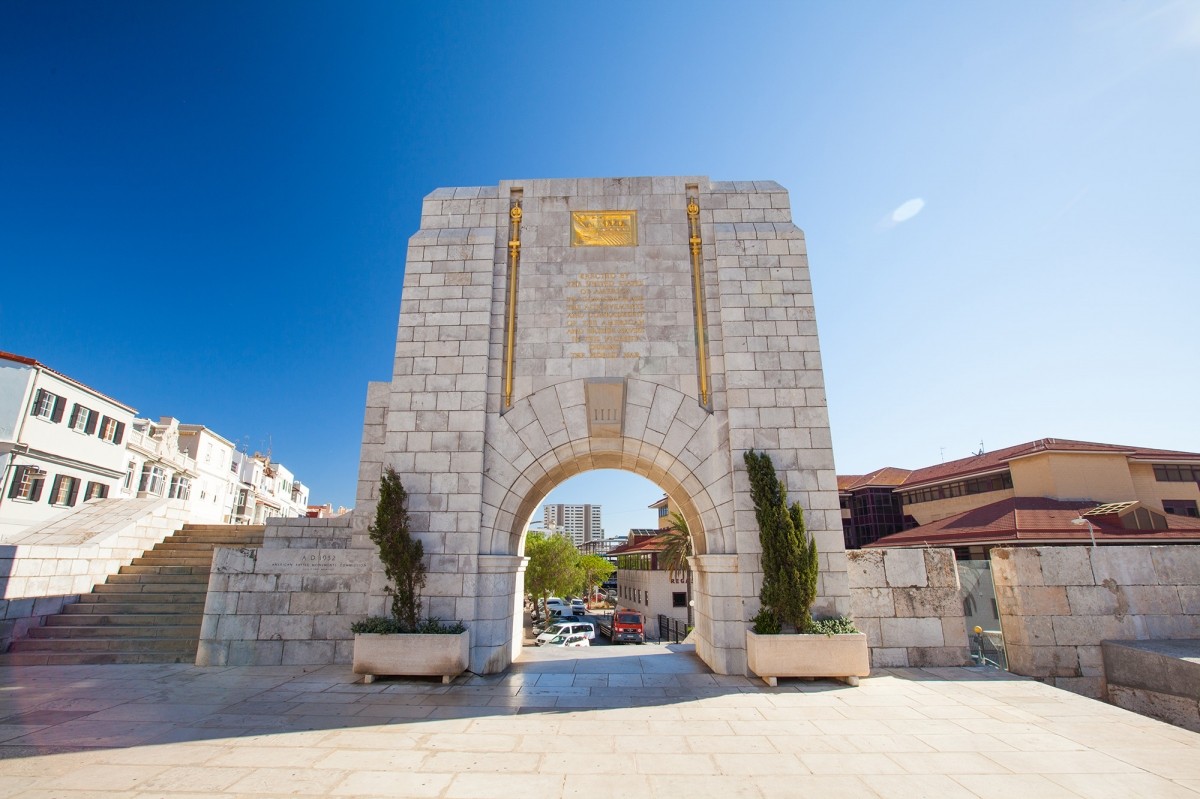
King’s Bastion
Walk down American Steps head south along base of walls towards King’s Bastion.
King’s Bastion: General Sir Robert Boyd who served in Gibraltar as Lt Governor and Governor from 1768 to his death in 1794 at the age of 84, designed King’s Bastion in 1772.
However, it is thought there has been a fortification of sorts on the same site as King's Bastion for more than 800 years. The first was probably a Moorish gate known as the Algeciras Gate decorated with rich Arab workmanship and incorporating a key design, still popular today. This was destroyed by El Fratino, an Italian military engineer in 1575 when the Spanish finally decided to strengthen Gibraltar's defences after prolonged and violent attacks from the Corsairs (Turkish pirates based across the Strait).
Fifty years later Philip IV called for further modernisation of the fortifications and Line Wall, including the San Lorenzo battery where King's Bastion now stands. The gun platforms were placed so they could give cover to their own ships sheltering in the lea and fire on any enemy vessels bombarding the city walls. When the British had to fight off the combined forces of France and Spain during the Great Siege in 1779 to 1783 King's Bastion proved invaluable.
The present bastion was designed by Lieutenant Governor Major General Robert Boyd as part of his overall plans created in 1769 to make Gibraltar an impregnable fortress. He was in charge of forming a company of military artificers in 1772, which later became the Corps of Royal Engineers.
The soldier craftsmen and labourers worked under Colonel William Green, Chief Engineer during the Great Siege and King's Bastion was their greatest work. Begun in 1773 and completed in three years, the bastion was a grand structure with casemates large enough for a regiment of 800 men. During construction, Major General Boyd incorporated a special vault for himself according to his wishes and although eventually buried there, no record exists of the exact site of the tomb. When laying the foundation stone Boyd had declared he hoped to live to see the bastion defy the combined might of France and Spain. It was only six years after its completion that it played just such a role. From there red-hot shot was first fired on the Spanish floating batteries and Governor General Eliott chose to stand there throughout the Great Siege attack of 1782.
In the 1960s the Bastion’s military use came to an end and was again modified, this time to house Gibraltar’s new power generating station. The station was designed by local architect Natalio Langdon, and was opened in October 1961. After closing down in the 1990s, the decision was taken to demolish it in 2005, so as to re-expose the original bastion.
King's Bastion was revealed again and its historical importance once more appreciated, when in 2000 the bastion was converted into the present day leisure centre, a clever fusion of modern leisure facilities and old military installations. It boasts a bowling alley, multi-cinemas, children’s play park, restaurants, events areas and gymnasium amongst other facilities.
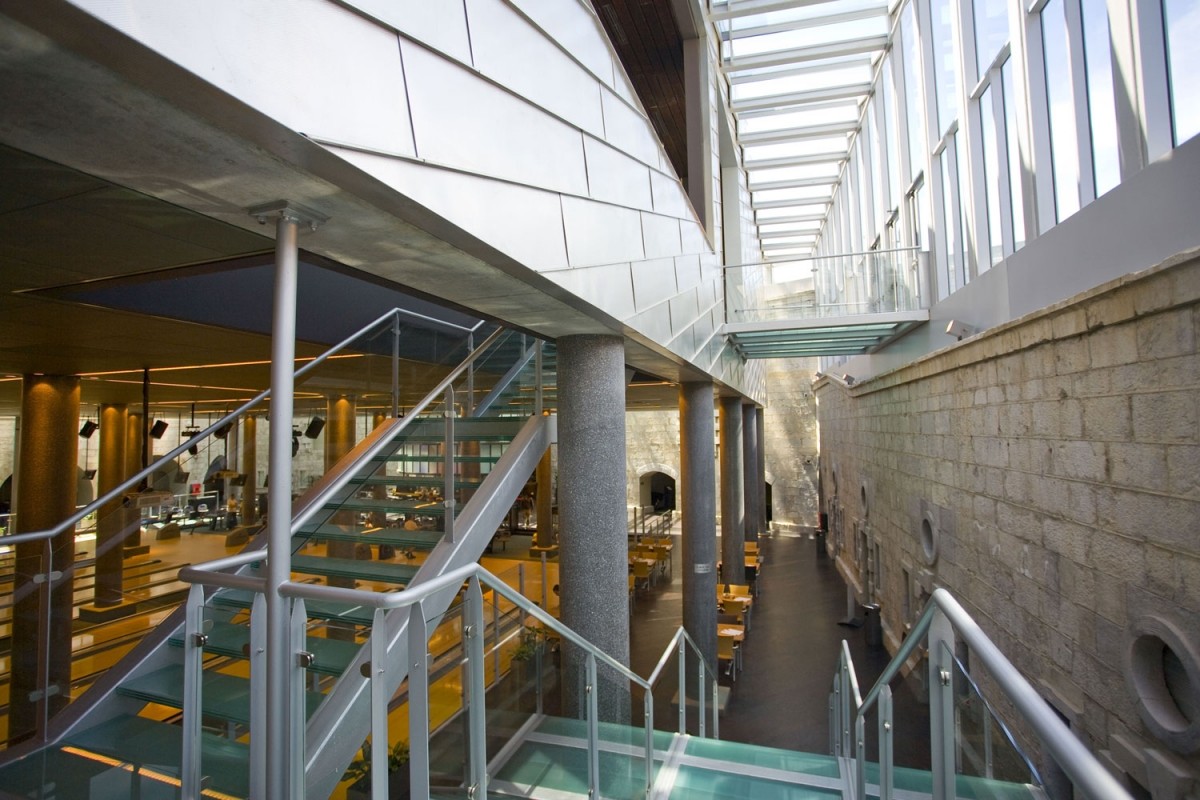
British War Memorial
Go up the British Steps and stop at the memorial.
British War Memorial: The Gibraltar War Memorial, also referred to as the British War Memorial. The monument, which commemorates the fallen of the First World War, was sculpted by Jose Piquet Catoli of Barcelona, Spain and was constructed of Carrara marble. The memorial was unveiled by the Governor of Gibraltar, Sir Charles Monro, during a ceremony on 27 September 1923. The Governor had the esplanade and steps built along the Line Wall Curtain for the residents of Gibraltar in 1921.
Adjacent to the monument are two Russian guns that were brought over during the Crimean War (1854–1856). The guns were given to Gibraltar in 1858 for its assistance during that conflict. The other two pieces of artillery are located at the entrance to the Gibraltar Botanic Gardens.
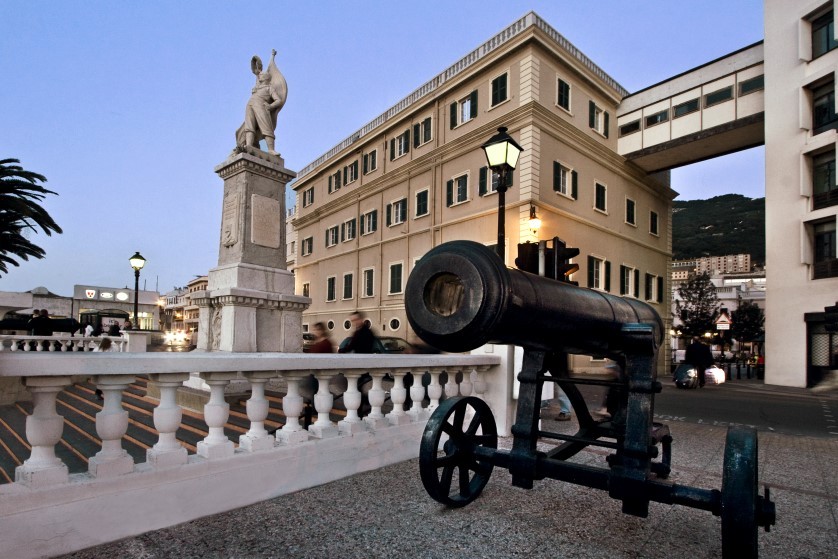
John Mackintosh Square
Cross road at pelican crossing and stop at John Mackintosh Square.
The Piazza: John Mackintosh Square, more commonly known as The Piazza has been the centre of city life since the 14th century and takes its name from John Mackintosh, a local philanthropist.
Originally known during the Spanish period as Plaza Mayor (Main Square) or Gran Plaza (Great Square) and afterwards as the Alameda (Spanish for an avenue lined with poplars, opened out from the west of Main Street. Two buildings separated it from the Line Wall a large rectangular building to the west of the square, and a smaller lower building to the south of it, the hospital and chapel of La Santa Misericordia (The Holy Mercy).
During the first century of the British period, the square was used for military parades by the garrison and therefore known as the Parade or Grand Parade. The square was also where military punishment in the form of floggings took place.
In 1704, after the city's capture by an Anglo-Dutch fleet, the British converted the hospital and chapel of La Santa Misericordia into a debtors' prison at the western end of the square.
In the mid-19th century the name of the square was changed to Commercial Square, being the site of a daily flea market and regular public auctions, as a result of which a Spanish name, Plazuela del Martillo, or more colloquially, El Martillo, was coined ("martillo" being the Spanish word for a gavel). Another popular name at the time was Jews’ Market. These appellations fell out of usage and the square is typically referred to as ‘The Piazza’, an Italian name created following the construction of a paved area in the centre of the square, probably introduced by Gibraltar's Genoese settlers. The name ‘John Mackintosh Square’ was officially adopted in 1940.
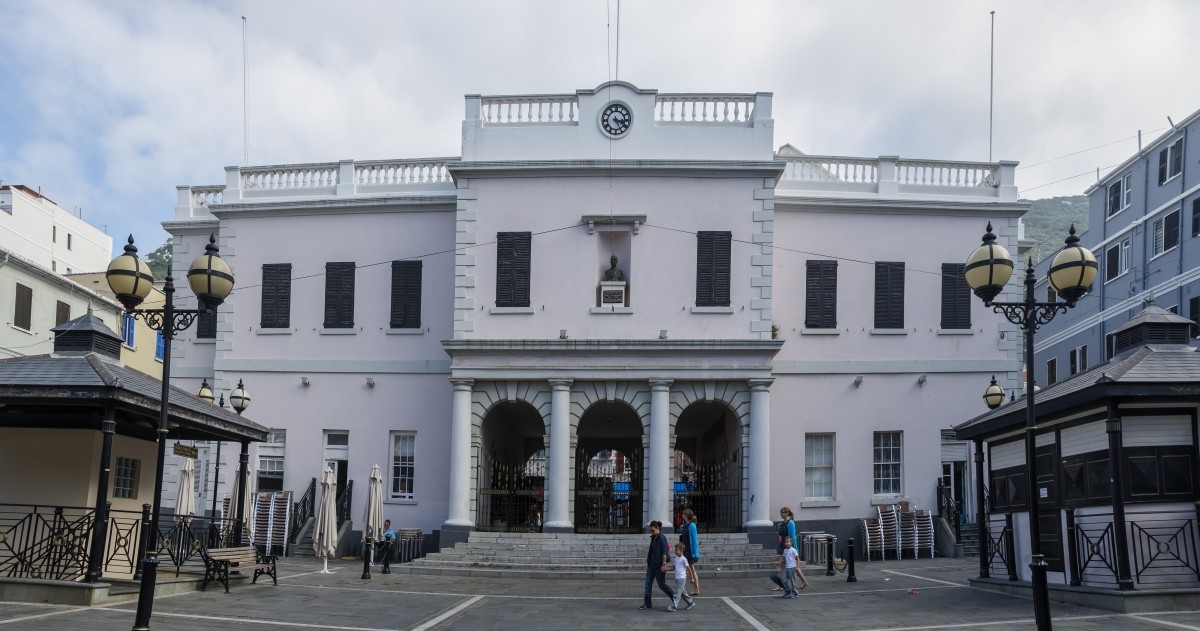
Parliament House
Face east looking at building between John Mackintosh Square and Main Street.
Parliament House: In 1817 local merchants raised money by public subscription to construct a building to house the Exchange and Commercial Library. In 1807, Gibraltar merchants had founded a library in Bedlam Court, as they were denied membership of the Garrison Library, it being available only to members of the British garrison in the city; civilians were excluded, regardless of their prominence. Ten years later, in 1817, they built themselves a new building on the east side of the square. It housed, not only a library, but also an auction room, and became the meeting place of local merchants. It became the Legislative Council and was inaugurated as such by the Duke of Edinburgh on 23 November 1950. Under the 1969 Constitution, the House of Assembly was established, superseding the Legislative Council. The first session of the House of Assembly, was opened in August 1969 by the then Governor Admiral Varyl Begg. The building was renamed Parliament House in 2007.
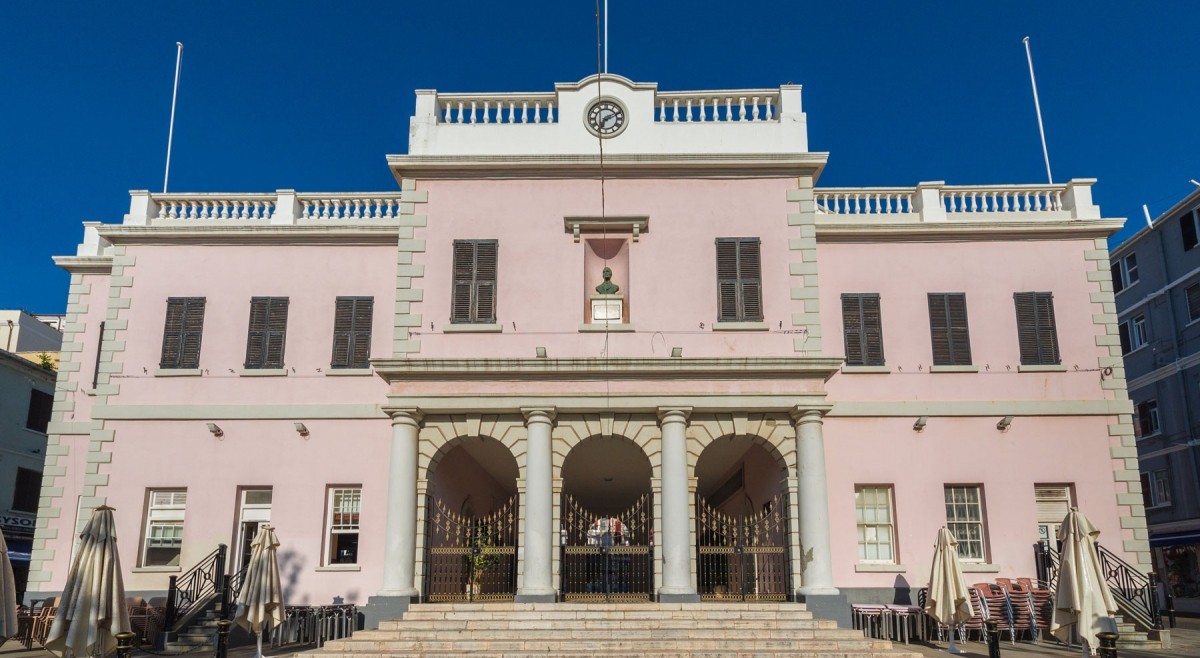
City Hall
Face west at building between John Mackintosh Square and Line Wall Road.
City Hall: In 1819, Aaron Cardozo, a prosperous merchant of Jewish Portuguese descent, built the grandest private mansion ever seen in Gibraltar. The three-storey house dominated the square. It was erected on the site of the old hospital and chapel of La Santa Misericordia and later prison. As a non-Protestant, Cardozo was not legally allowed to own property in Gibraltar. However, as he had been a close friend of Horatio Nelson and had supplied his fleet, Cardozo was eventually granted this site to build a house in the Alameda on the condition that it be ‘an ornament’ to the square. Its cost was about £40,000. After his death in 1834, his mansion was rented out as a hotel called the Club House Hotel. It was bought in 1874 by Pablo Antonio Larios, a wealthy businessman and banker, Gibraltarian-born and member of a Spanish family, who completely refurbished the building. In 1922, his son Pablo Larios, Marquis of Marzales, sold the building to the Gibraltar colonial authorities, who intended to turn it into a post office. However, it eventually became the premises of the newly formed Gibraltar City Hall. Nowadays it houses the Mayor's Parlour, Ministry for Culture and National Art Gallery.
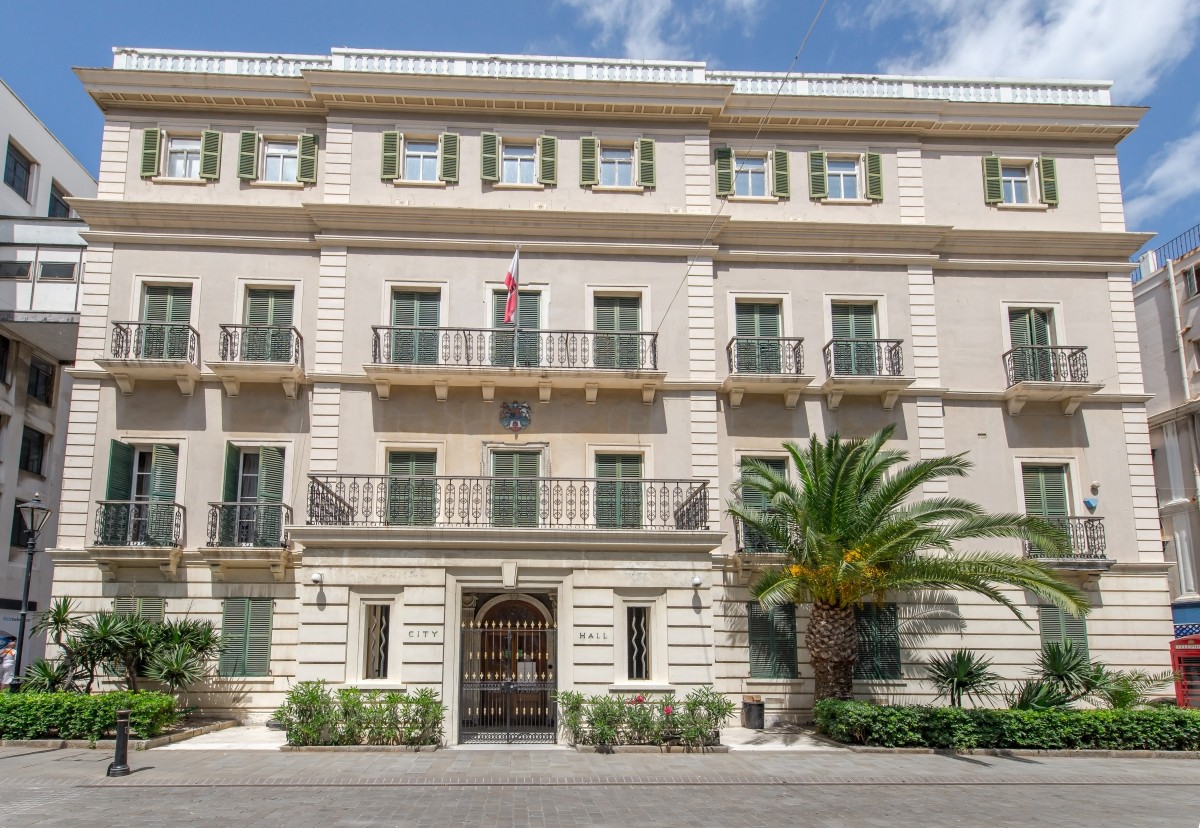
The Gibraltar Heritage Trust Building
Face south at building between Gibtelecom and parade of shops:
The Gibraltar Heritage Trust Building: After the Great Siege, a colonnaded Georgian guardhouse was built on the southern side of the square. It was the Main Guard, the place from which all the sentries in Gibraltar were posted each evening. Some years later it hosted the then Fire Brigade. After the move of the brigade to the fire station at Victoria Battery in 1938, it became the Rates Office, later the Arrears Section and Transport department. Today the old guardhouse houses the Gibraltar Heritage Trust and a Gibraltar Tourist Board information counter.
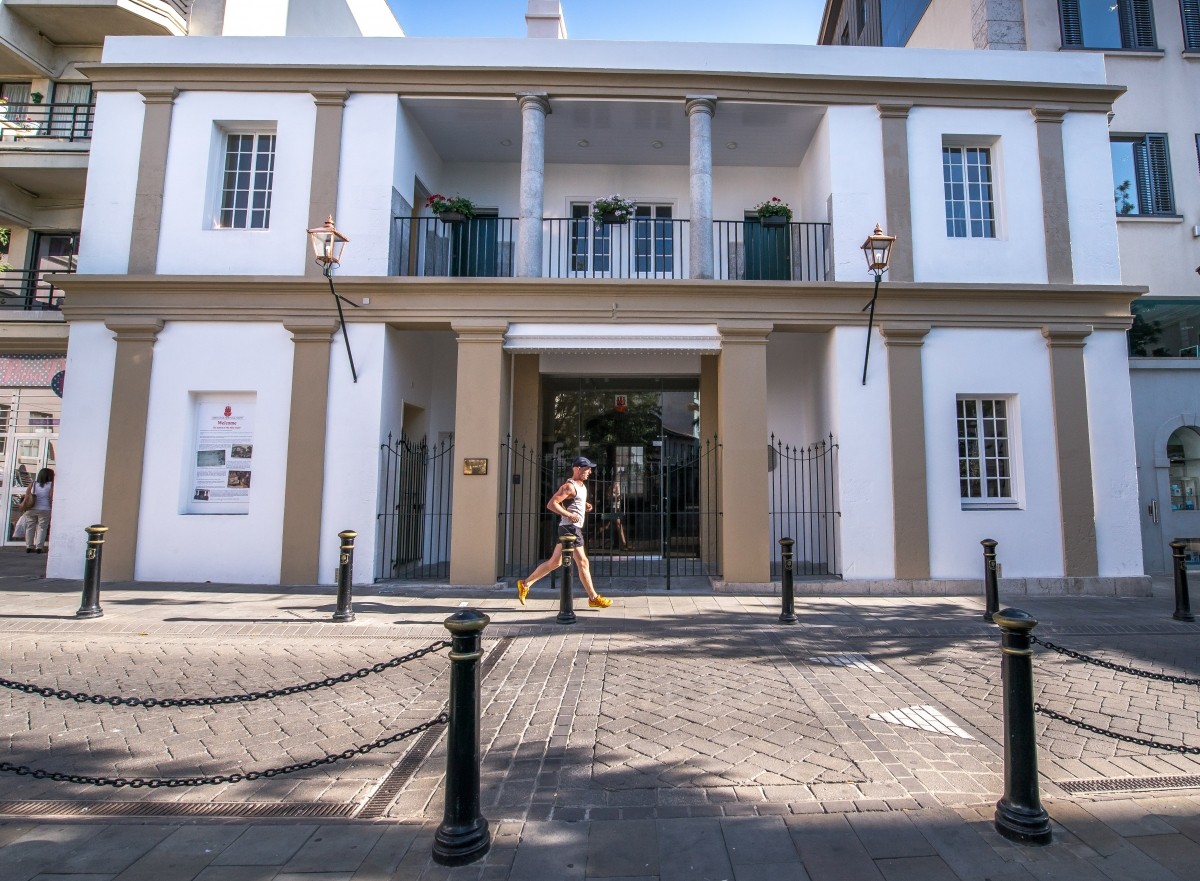
Unique Buildings
Head onto the Main Street and turn right.
Although it is tempting to stop and look at shop windows do not forget to look up at the buildings. These properties are unique as they reflect the diversity of nationalities that make up the Gibraltarian. These include amongst others, Georgian timber sash windows, Genoese-style shutters, Portuguese-style tiled façades, regency wrought iron balconies, Andalusian-style ceramic roof tiles and inner patios, Victorian ogee cornices and heavy British military-inspired carved keystones, arched stone doorways and other stonework. During the Great Siege, which lasted in the region of four years, the town suffered widespread destruction. As a consequence, civilians resorted to rebuilding in the previous Moorish style, using the old foundations as a guide line which resulted in the existing narrow streets, arches, mazes of steps and alley-ways as can be seen in the upper town. The garrison were able to undertake a bigger project of rebuilding and produced the bastions, gateways, defences and walls (many of which still exist today).
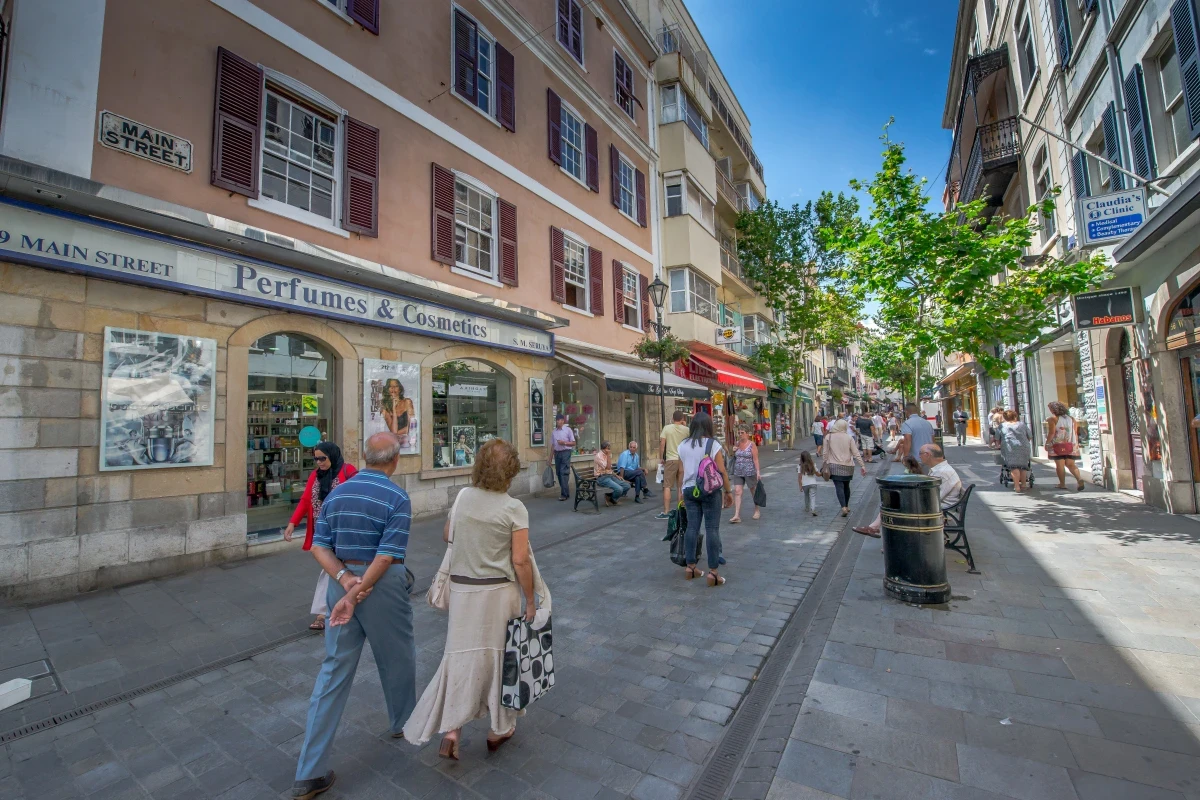
Cathedral of St Mary the Crowned
Stop opposite Gibraltar International bank.
Cathedral of St Mary the Crowned: This Roman Catholic Cathedral is built on the site of what used to be a very beautiful and richly decorated mosque. After the Christians drove the Moors from the Rock in 1462, the Mosque was used as a church until the Catholic Kings, Ferdinand and Isabella, decreed that it be stripped of its Islamic past and extended. They donated bells and a clock for the 100ft tower, which remain to this day, and their Coat of Arms was placed in the courtyard where it can still be seen.
The courtyard was four times its present size and contained an orange grove surrounded by cloisters. The church itself extended to the opposite side of what is now Main Street. During the Great Siege (1779-1783), it suffered tremendous damage and despite the attempts of returning exiles to rebuild gradually, scant progress was made.
In 1790, Governor Boyd offered his assistance in return for a third of the land on which the building stood, enabling him to re-route Main Street. An on-going after-effect of this loss of ground is that mortal remains are frequently uncovered during routine excavations of the road outside.
These days, only Bishops are honoured with internment in the Cathedral, in the crypt under the Statue of Our Lady. But up until the 1800s, any person who died in Gibraltar had the right to be buried under the floor of the Cathedral. The sacristan enjoyed this business ‘on the side’, it was later discovered. Such was the privilege of being buried in holy ground, people from outside the town willingly paid bribes in return for a guarantee of a reserved plot. The unscrupulous sexton would exhume recently buried corpses and burn them in quicklime in the so-called ‘Room of the Goat’ at the back of the church, thus freeing spaces for ‘his clients!’.
Situated in the courtyard is the Shrine of Our Lady of Lourdes, her statue having been placed there in gratitude in 1858 by Bishop Canilla, whose brother had been miraculously cured of a tumor during a visit to Lourdes. The grateful Bishop also placed a large statue of Our Lady at the top of the tower for all to see, but this was removed at the turn of the century. Inside the Cathedral the High Altar is very grandiose and is in the style of that of St. Peter’s in Rome. The beautiful marble plinth and columns with the six-ton bogatino top were originally bound for South America when the ship carrying this precious cargo sunk in the harbour. The Arengo family bought the salvage rights and installed the marble in the Cathedral as their family altar, it was later placed in its present position. The silver was brought back from the New World 500 years ago.
The Cathedral is named after Our Lady of Europe and there is a statue in her honour at the altar. A duplicate of the original is in the shrine at Europa Point. People come from all over Europe to pay their respects.
Another statue has been given the rather unusual name of Our Lady of the Flannels, she was found floating in a box in the harbour sometime in the 18th Century wrapped in flannels.
On one of the walls is a plaque commemorating the death in Gibraltar of General Sikorski, the wartime Polish Prime Minister. The liberator aircraft in which he was to have flown to England, crashed into the sea off the east side of the Rock after take-off. His body was brought to the Cathedral for blessing before being transported to England in a Naval Destroyer. After the war, the Poles presented a picture of Our Lady of Chestochowa which now hangs next to the plaque in memory of that great man.
The history of St. Mary the Crowned goes on and on! In 1951, the whole city was shaken when an ammunition ship the Bedenham, exploded in the harbour. Debris flew in all directions and a large piece of the ship hit the top of the Cathedral causing a serious crack. This was only discovered a few years ago, initiating extensive renovations to the top of the facade
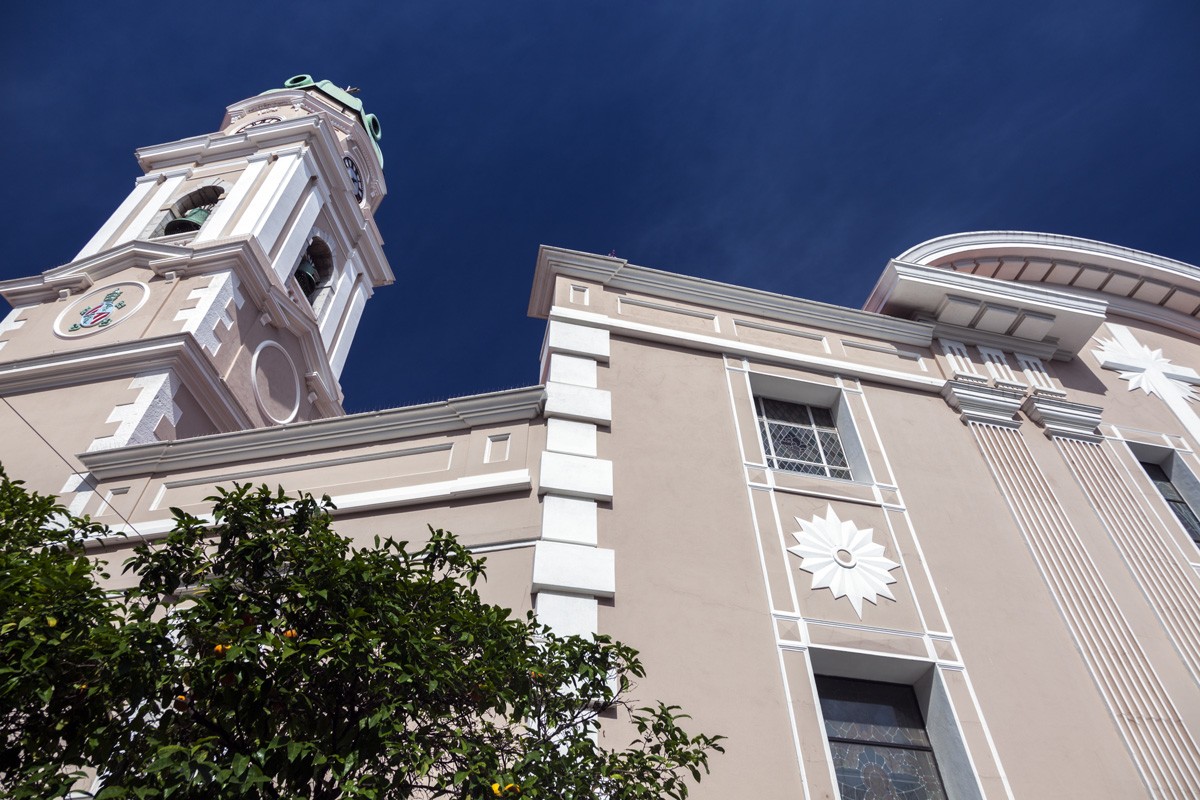
Royal Engineers’ Memorial
Face the monument outside the Cathedral at junction with Bomb House Lane.
Royal Engineers’ Memorial - The 1772 Sapper Statue: The monument comprises a life size bronze statue of a Sapper dressed in 1772 uniform, mounted on a limestone rock from Gibraltar.
Members of the Royal Engineers have served on the Rock since it was captured by the British in 1704. One of the first Royal Engineers to serve on the Rock was Captain Bennett. He arrived with Admiral Sir John Leake from Lisbon in November 1704. Bennett supervised the development of the fortifications and dug a series of mines into the glacis of the Land Port.
The next significant visitor from the Corps was Colonel (later Major General Sir) William Green. He arrived in 1761 as Senior Engineer and stayed for over 20 years. His first task was to prepare plans for the modernisation of Gibraltar’s defences. Green’s greatest work was King’s Bastion.
Colonel Green submitted the suggestion of the formation of a company of military artificers to the Governor and Lieutenant Governor of Gibraltar. Too well aware themselves of the disadvantages of the system of civil employment in carrying on the works of the fortress, they were favourable to the trial of any experiment that promised success; and in recommending the plan to the attention of the Secretary of State, they expressed their decided opinion that many advantages would certainly arise by its adoption. The royal consent was accordingly given on the 6 March, 1772; and thus originating the Corps.
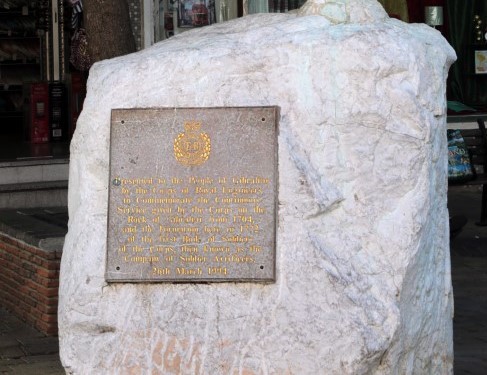
The Garrison Library
Walk up Bishop Rapallo Ramp stop outside the O’Callaghan Eliott Hotel and face the grand building opposite the hotel.
The Garrison Library: This magnificent building was built on the site of the former Spanish Governors’ residence in Spanish times, inaugurated in 1793 and completed in 1804. The Garrison Library’s founding was due to the perceptive Captain (later Colonel) John Drinkwater, author of one of the most famous histories of the Great Siege of Gibraltar. Having suffered from a lack of reading material during the siege, Colonel Drinkwater saw the need for a good circulating library and club as a means of saving the officers of the garrison from “having their minds enervated and vitiated by dissipation”. His appeal for books, made shortly after the siege, attracted nearly 500 gifts, which enabled the library to open pending the arrival of the 674 volumes on order from London, there being no bookshop in Gibraltar at that time.
The library now houses thousands of books, including many rare volumes and offers an excellent local history collection. It contains many of the finest books published in the eighteenth and nineteenth centuries, lithographs and art prints are also held here and even the furnishings are said to have interesting historical backgrounds. The building also served as the headquarters and archive service of the Gibraltar Chronicle, the world's second oldest English language newspaper.
Currently the library has become the epicentre for the Prestigious Gibunco Gibraltar Literary Festival, held in the autumn.
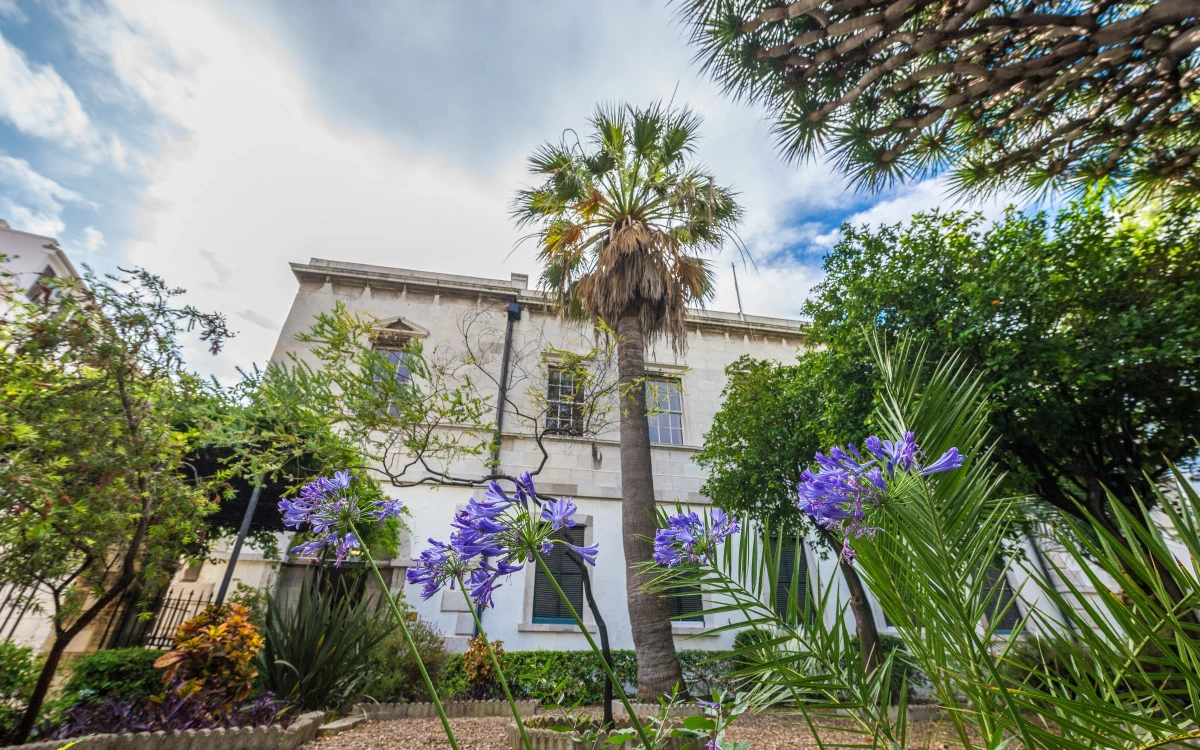
St Andrew’s Presbyterian Church
Face the church at the south end of the car park.
St Andrew’s Presbyterian Church: The foundation stone was laid in 1852 by Mrs Grey, wife of the then Captain of the Port. After many difficulties, which were overcome by the determination of the Presbyterian community, the church was formally opened by the Rev James Drummond of Forgandenny, Scotland in 1854.
For many years there had been some agitation to secure a building for the use by the Presbyterian community, but it was not until 1843 that any positive action appears to have been taken. Until the new church was opened in 1854, Presbyterians met for worship in the Exchange Rooms, the Wesleyan chapel, various other buildings, and the homes of members. The fight which lasted 11 years was however due to commence and following a declaration a committee was formed representing Presbyterians of the various military units, Government Departments, and the civilian population. For the next five years many peaceful approaches were made officially and unofficially for a grant of Crown land on which to build a Church. No success attended these efforts, and subscriptions were more forthcoming until some concrete proposal was placed before the public.
In March, 1849, a memorial was presented to the Governor praying for a site to be given to the Presbyterians on which they could build a church. His Excellency agreed that he would consider any proposal. In June 1849, various sites were suggested but the Church Committee were told that they could not have them as "they may be required for Government purposes at some future date."
A member of the Church Committee went to London in 1850 and saw a number of Colonial Office officials who said they supported the idea of a land grant for the Kirk, and would write to the Governor accordingly. The sole outcome of this was a complaint by His Excellency about the unorthodox approach to the Colonial Office. No land was forthcoming.
Memorials to the Secretary of State for the Colonies and even to Queen Victoria, produced no result, and it became apparent that if a site was to be obtained, the whole cost would have to be met by voluntary subscription.
The church was built mainly by local labour under the direction of the honorary architect - Walter Elliot. Whilst much of the stone came from Gibraltar and Spain, it is recorded that three stone masons came with special stone from Malta.
In February, 1854, work on the church was stopped because funds were exhausted, but this problem was solved by members making a temporary loan of $500.00. The original plans of the church were slightly altered before work commenced, but many alterations have since been made to the interior.
During the past hundred years, considerable improvements have been made to the Church by way of alterations, additions and gifts.

Nefusot Yehuda Synagogue
Walk down Library Street, turn right on Main street and at the Sapper’s Statue head left down Bomb House Lane take the right alley way to Line Wall Road.
Nefusot Yehuda Synagogue: This Synagogue dates from 1800. Moroccan influence inspired a number of members to build a new synagogue which would revert to the old Dutch customs and order of service. The years from 1793 onwards were ones of great prosperity in Gibraltar as a result of the French Revolution and Napoleonic Wars, giving rise to Gibraltar merchants becoming very wealthy through their ownership of privateers and dealing in the rich enterprises they brought into the Port of Gibraltar. So a grand new building was constructed for a sum of $26,300 (almost £6,000 at the time) on a garden that Shemtov Sequerra, a local Jewish merchant, had bought from John Crusoe. The building was opened for worship in March 1799. The old palm tree in the Courtyard is all that remains of the garden in which the synagogue was built. The Dutch bell gable can still be seen. The interior was gutted by fire in the early years of the 20th century, and was rebuilt by an Italian architect from Carrara.
This building is therefore, a mixture of styles, Dutch outside and Italian inside, with the reading desk (teva or bima) built into the ark (hehal) instead of being separated as is more usual in Sephardi Synagogues. From its foundation until 1882, the minister of the synagogue was a member of the Conquy family. The story revolves round the adventures of the Conquy family, who were supposed to have been the original inhabitants of Gibraltar. In fact, the Conquy family came to Gibraltar from Amsterdam in the 18th century. The extent to which the congregation of Nefustot Yehuda went to keep to Dutch customs is demonstrated by the fact that in the early years of the synagogue, the ketubot (Jewish marriage contracts) used were sheets taken from a printed book with numbered pages, instead of the hand-illuminated parchments generally used in Gibraltar.
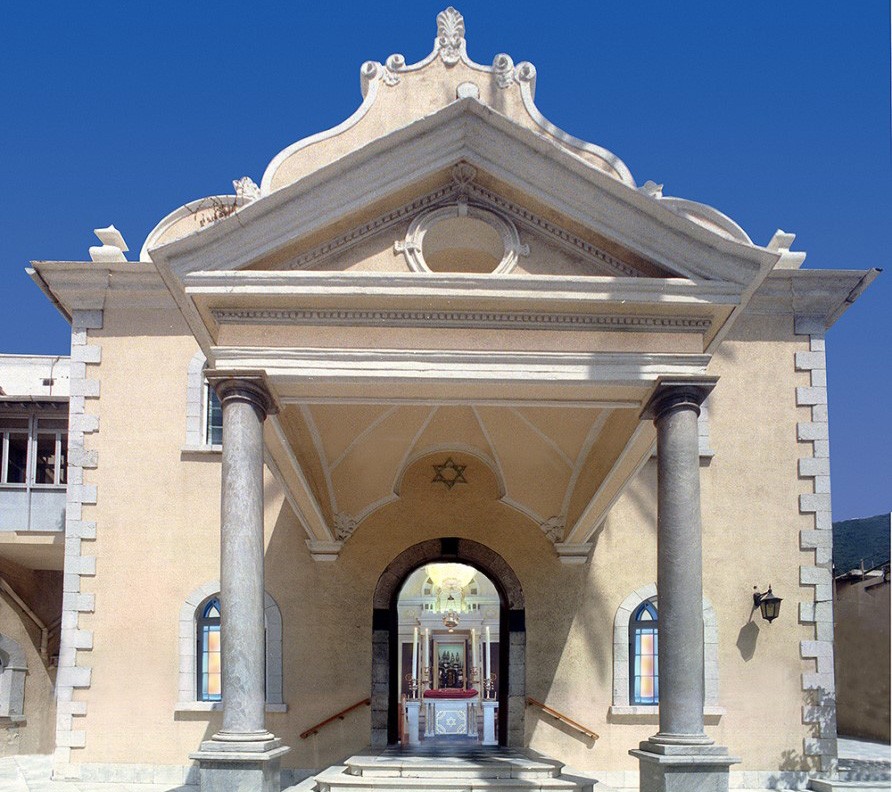
Gibraltar National Museum
Walk back to Bomb House Lane to entrance of The Gibraltar National Museum.
Gibraltar National Museum: The Museum was founded in 1930. Located in the city centre it houses a fascinating array of cultural and natural history collections, prints, paintings and drawings, and objects from 127,000 years ago to the present day. Parts of the building date back to the 14th century, when an impressive set of baths was constructed in what is now the basement of the Museum. These Moorish Baths, contemporary with the castle, are some of the finest remains of the period in the Iberian Peninsula. They have been fully excavated and are incorporated into the Museum’s displays. Importantly, the Gibraltar National Museum is the main interpretation hub for Gibraltar’s newly-inscribed UNESCO World Heritage Site – Gorham’s Cave Complex. The site was added to the UNESCO List on 15th July, 2016 as an exceptional testimony to the occupation, cultural traditions and material culture of Neanderthal and Early Modern Human populations through a period spanning more than 120,000 years. Museum displays include ‘Nana and Flint’ – two very accurate forensic reconstructions of a Neanderthal woman and child taken from the two Neanderthal skulls found in Gibraltar in 1848 and 1926 and a film on the making of the Neanderthal models by the Kennis Brothers.
The Rock has been a world symbol for three millennia and the museum houses exhibits dedicated to the Rock as a symbol from the Pillars of Hercules to present day. In the garden - an archaeological excavation covering seven centuries of Gibraltar's history. Natural History of Gibraltar including reconstructions of past landscapes. The Moorish Baths and medieval Gibraltar. The Age of Exploration – 18th and 19th century scientific discoveries in Gibraltar including the two Neanderthal skulls. The Great Siege - dedicated to the Great Siege of Gibraltar (1779–1783). Rock model –an 8-metre (26 foot) long scale model of Gibraltar in 1868 and also includes old photographs of Gibraltar.
Anglican Cathedral of the Holy Trinity
Despite its deceptively Moorish appearance, ‘Holy Trinity’ was not built until 1825. It was consecrated in 1838 at a service attended by Queen Adelaide, widow of William IV. Among those buried here is General Sir George Don under whose direction the cathedral was erected during his posting as Lieutenant Governor of Gibraltar (1814 - 1832). The Holy Trinity Anglican church was raised to cathedral status in 1842, becoming the centre for Anglicans in all Europe except the British Isles. Today its diocese is called ‘The Diocese of Gibraltar in Europe’.
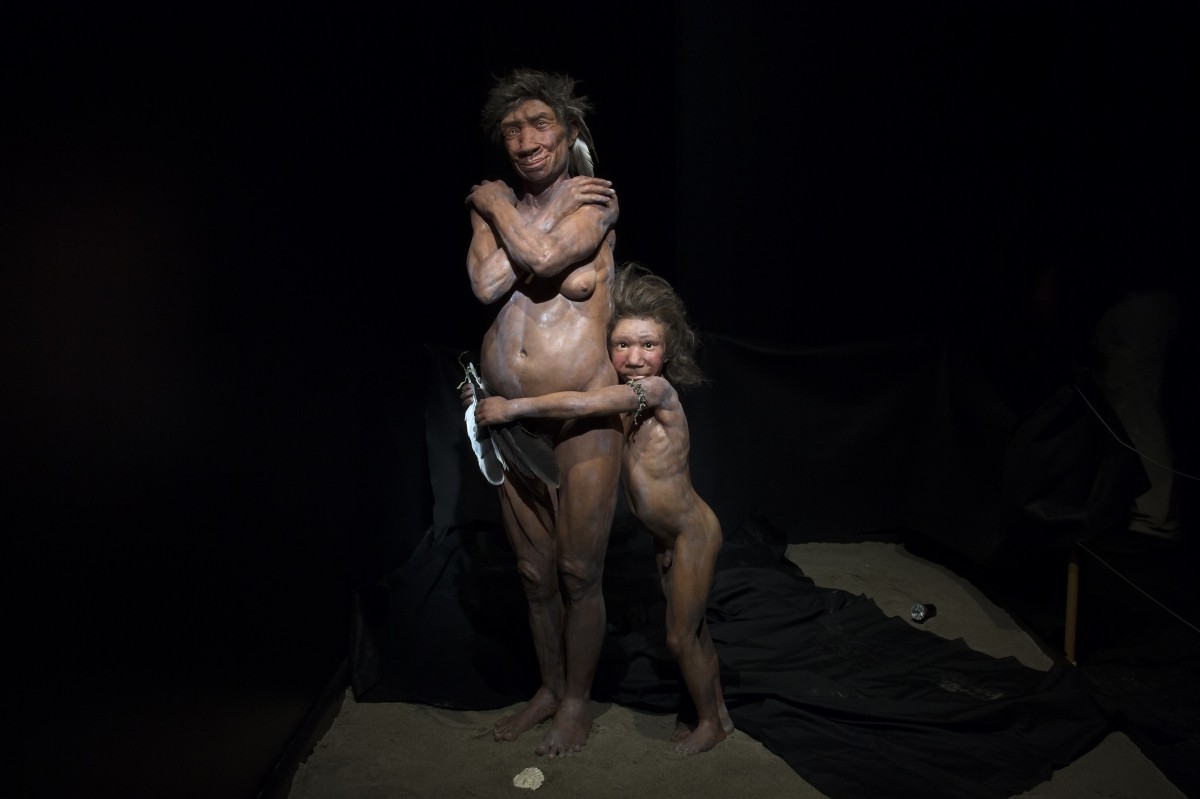
Duke of Kent House
Outside the Cathedral look to the building to your left to the south of the playground.
Duke of Kent House: Prince Edward, Duke of Kent and Strathearn (Edward Augustus; 2 November 1767 – 23 January 1820) was the fourth son of King George III of the United Kingdom and the father of Queen Victoria. The Duke tended to live in splendid isolation in this house at Line Wall – although he was sometimes accompanied by his mistress, Alphonsine Saint Laurent. They never lived in the Convent which was still being repaired after the damage done to it during the Great Siege and only used it for entertainment purposes.
Appointed Governor of Gibraltar by the War Office, the Duke took up his post on 24 May 1802 with express orders from the government to restore discipline among the drunken troops. The Duke's harsh discipline precipitated a mutiny by soldiers on Christmas Eve 1802. The Duke of York, then Commander-in-Chief of the Forces, recalled him in May 1803 after receiving reports of the mutiny, but despite this direct order he refused to return to England until his successor arrived. He was refused permission to return to Gibraltar for an inquiry and, although allowed to continue to hold the governorship of Gibraltar until his death, he was forbidden to return.
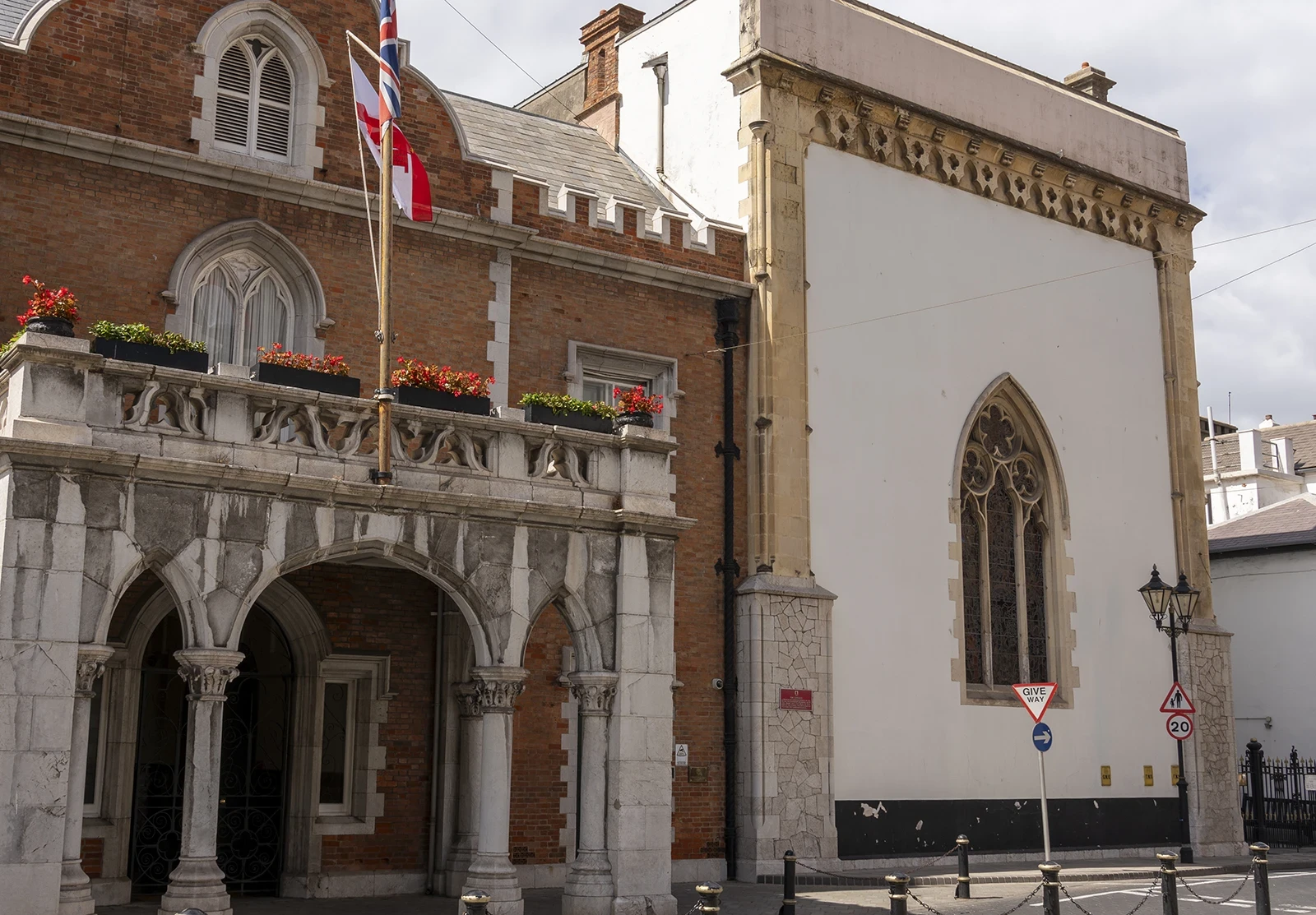
Supreme Court
Head back onto Main Street, behind the Cathedral and walk south - stop outside the Law Courts.
Supreme Court: The Supreme Court was built in 1820 on site of an old Judges Advocate Court House 1750. Under charter of William IV it became the Supreme Court of Gibraltar – restored to its in 1888 and in recent years. New courts opened in September 2012. The new purpose-built building houses seven courts, one for a Coroner, two for Magistrates and four supreme courts.
The legal system of Gibraltar is based on English law and is a mix of common law and statute. The hierarchical system of courts includes a magistrates' court, a supreme court and a non-resident appellate court.
Probably the most famous case heard here was that of the sailing ship ‘Mary Celeste’ (1872) reputably the greatest sea mystery of all time. Gibraltar is also a popular wedding destination – John Lennon and Yoko Ono married at the Registry Office in this building on 20th March 1969. Many other famous people have also married here, such as Sean Connery (twice). The Registry Office has since been moved to a Gibraltar Government Building nearby.
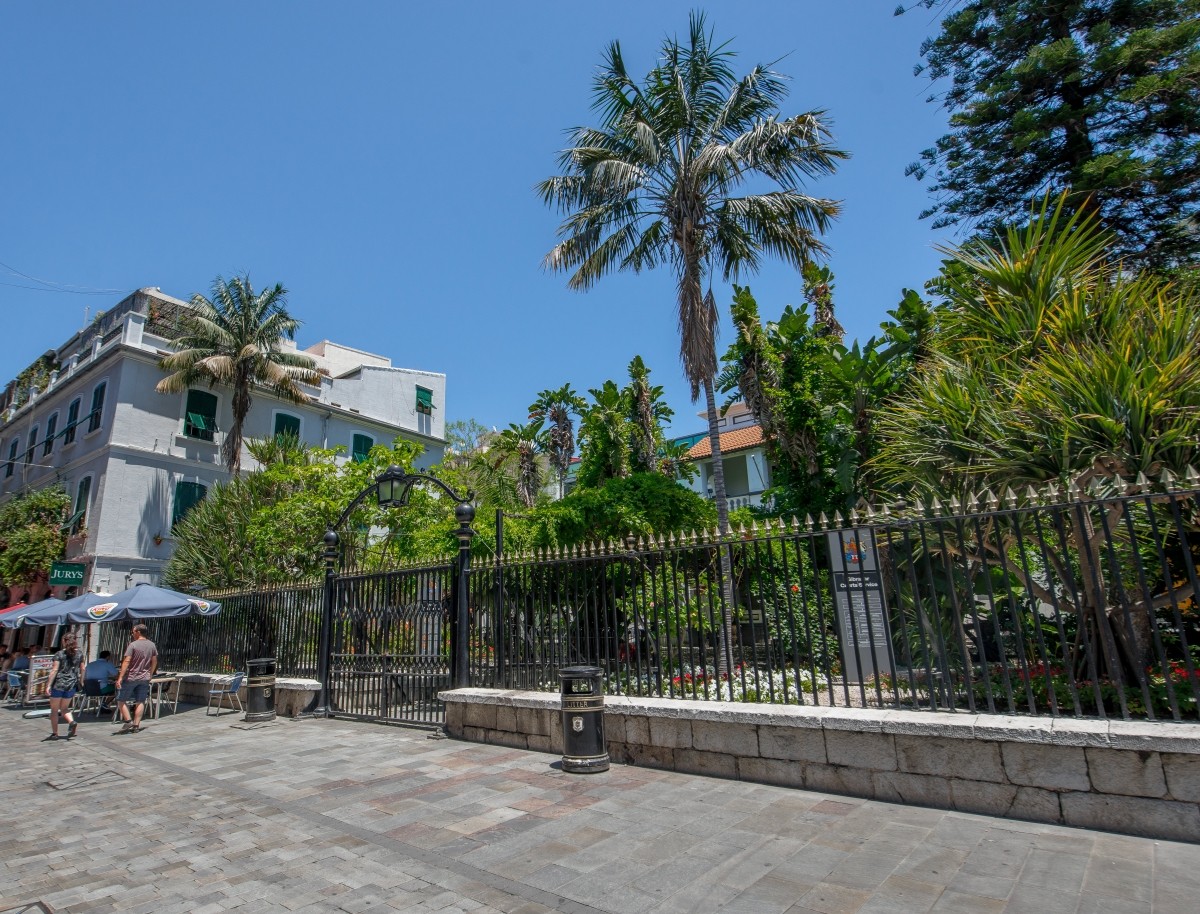
The Convent
Continue walking southbound and stop outside Governor’s Residence.
The Convent - Residence of the Governor: A former Franciscan Convent, established in 1482 was transferred to this site in 1521 and later became the British Governors’ residence in 1711. The Kings’ Chapel is the chancel of the old convent chapel, the nave, for years used for other purposes, is now the Church Hall.
When the Christians captured the Rock in 1462, a number of religious orders established themselves in Gibraltar. Franciscan fathers took up residency in the area of what today we call The Convent, in about 1480. In 1531, Francisco de Madrid paid for a chapel and for a considerable extension to the earlier Convent.
Shortly after the capture of Gibraltar by British and Dutch Forces for one of two pretenders to the Spanish throne in 1704, the Franciscan friars left. The building, probably slightly damaged during the capture, stood abandoned until 1728 when it was taken over as the palace for the military Governor. The name ‘Convent’ from the Spanish ‘Convento’ (used in Spanish both for monasteries and for convents) has been used almost continuously since the first convent in the 15th century. Between 1903 and 1943 it was called ‘Government House’. We owe the reinstatement of the historic name to King George VI, who so ordered after his visit to Gibraltar during WWII.
The siege of 1727 caused much damage to the old building but this was small by comparison to the severe damage caused during the Great Siege (1779/83) from enemy bombardments both from land and from the sea. Major restoration no doubt commenced after the Great Siege but the most striking alterations were effected in 1863/64 under Lieutenant General Sir William Codrington KCB, the then Governor. This Governor had the Banqueting Hall rebuilt and the façade overlooking Main Street was totally changed from the back door it had been to the new attractive front entrance we now enjoy. The main staircase by the entrance probably belongs to this major renovation.
In 1951 the SS ‘Bedenham’, an ammunition ship, blew up in the inner harbour, but only at a distance of 360 yards. The Convent and its chapel suffered badly as did much of Gibraltar. The Banqueting Hall suffered irreparable damage to its three stained glass windows (1863).
Like many ancient buildings, the old Convent attracts a story or two but perhaps the best known is the one about the Spanish nun brought to this monastery to be executed after having tried to elope with her sweetheart, a monk, in a rather bizarre fashion and thus becoming The Convent’s resident ghost, the Grey Lady.
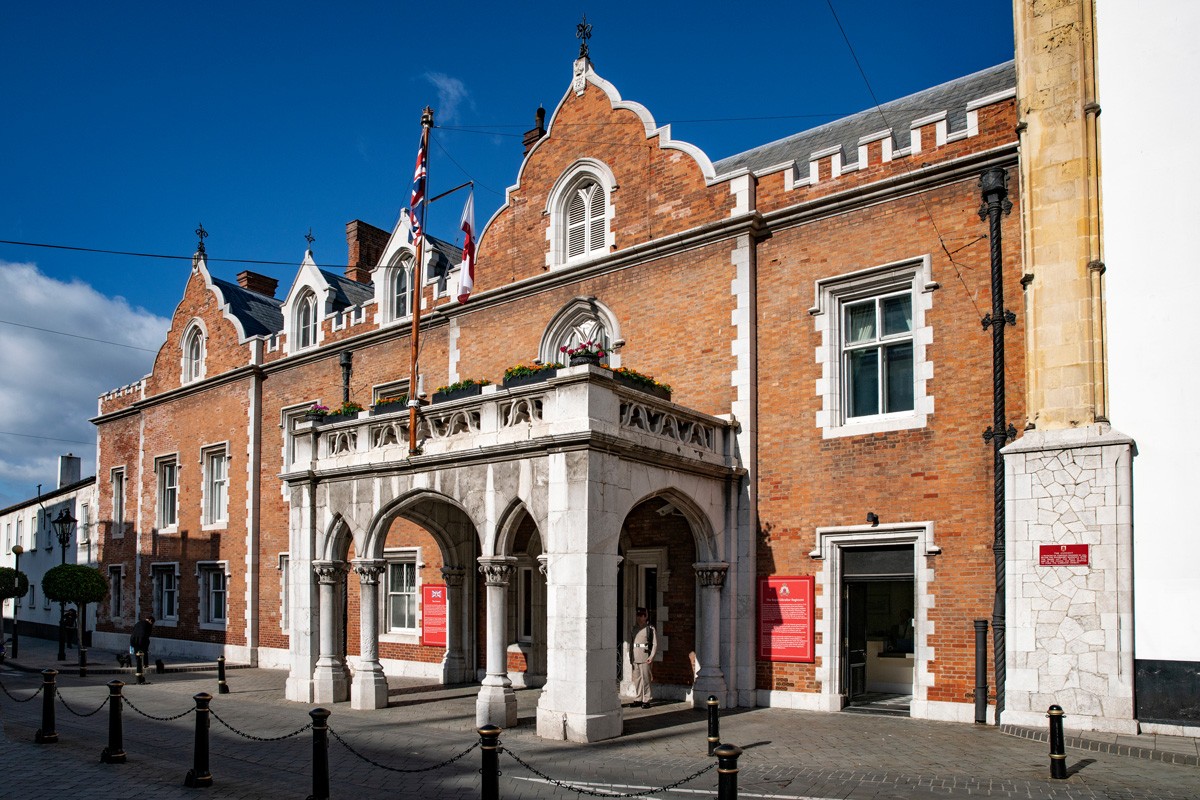
King’s Chapel
Face the Convent, look at building located to its right.
King’s Chapel: The Chapel to the Convent is now about half its original size. The Chapel, too, suffered during the sieges and the rising cost of repairs in the 18th and 19th century were a strong contributing factor in the redeployment of its space. It was superseded for general use by the Cathedral of the Holy Trinity, which was completed in 1832, and became the Governor's private chapel for a short period. In 1833 an order was received from London for the closing of the King's Chapel, which was met with vigorous protests in Gibraltar. The congregation were told that they would have to pay a pew rent sufficient to maintain a military chaplain at a cost of five shillings a day. They were apparently unwilling to do so, and the chapel was duly closed.
However, it gained a fresh lease of life in 1844 when it was restored by the Royal Engineers to serve as an auxiliary place of worship for Gibraltar's civilian population. So many military personnel were now using the Cathedral of the Holy Trinity that there was little room left for the civilians.
The chapel's restoration saw the creation of new stained glass windows that were installed in 1952. The window in the north transept depicts King George VI, while that in the east wall shows Christ in glory surrounded by the Archangels Raphael, Gabriel, Uriel and Michael. The crucifixion is located immediately below, with the Virgin Mary and St Bernard, Gibraltar's patron saint, on either side. Other panels in the window depict worshippers from the British Armed Forces, members of the Franciscan Order, the capture of Gibraltar in 1704, Saint George, the Royal Arms and the crest of the British Army. The chapel houses many memorials to members of the British Armed Forces, as well as the tombs and memorials of a number of governors and their wives.
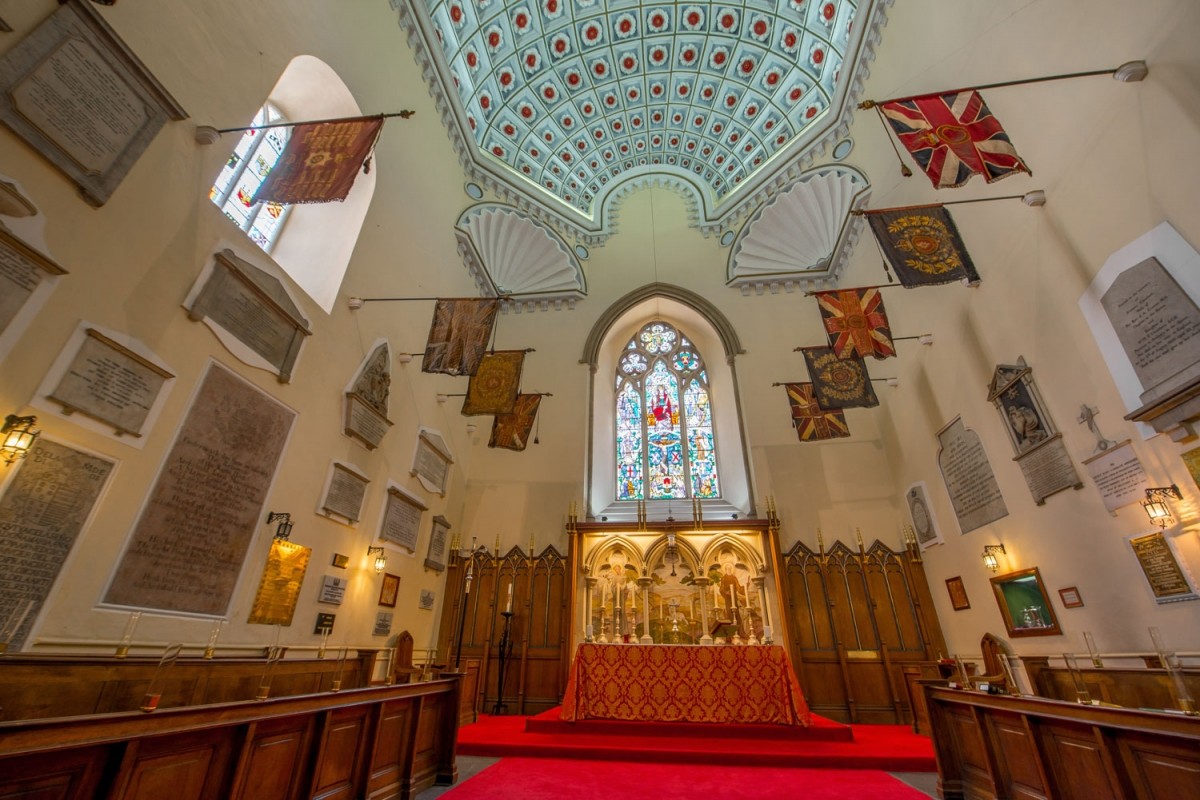
Methodist Church
Continue walking southbound; stop before you arrive at Victualling Office Lane:
Methodist Church: The church on the 1st floor transferred to this location from Prince Edward’s Road where it had been established since early 1803. The Methodist Church in Gibraltar was founded by a group of ‘soldier preachers’ in the early months of the year 1769. The first permanent meeting place was the home of Sgt. Major Ince who was himself a Methodist preacher and was to become famous for his work on the Upper Galleries. Despite great difficulties, the Church grew, and in 1804, the first Methodist Minister was appointed, charged with the care of both service and civilian members of the society.
In the early 1800s the first church was built in Prince Edward’s Road upon the site of Sgt. Major Ince’s army quarter. Later a manse and school were added. In the middle years of the 19th century Methodist work spread from Gibraltar into Southern Spain where both church and schools were established. In the early 1890’s part of the school in Gibraltar was converted into a recreation club for the soldiers and sailors stationed on the ‘Rock’ who had previously availed themselves of the ‘home from home’ provided by a succession of Ministers and members of the Methodist community. In 1898 the social work of the Church expanded with the opening of the ‘Welcome Soldiers and Sailors Home’ at what was then No.6 Church Street. In 1933 the ‘Welcome’ removed to its present site at No.297 Main Street.
During the years from 1898 to the advent of World War II the ‘Welcome’ served thousands of service personnel of all faiths and of none. During these years, also the Methodist Church in Spain was greatly strengthened by the support of Methodists in Gibraltar. After World War II the old ‘Welcome’ became a ‘Wesley House’ and the social work among the service personnel of all nations was continued and extended.
In 1956 the church in Prince Edward’s Road was sold along with the manse and the present building was reconstructed to house a church, church parlour, quiet room, restaurant, etc.
There is now a flourishing congregation and a large house group, as well as the ‘Carpenter’s Arms’, an alcohol-free bar lounge. The lounge is part of the outreach to the whole community replacing the restaurant. The Church also plays its part in Ecumenical activities.
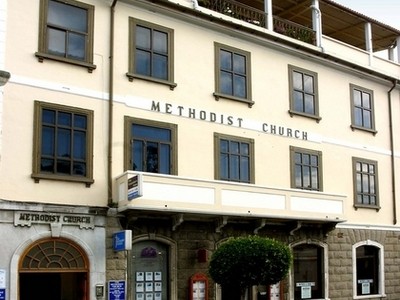
John Mackintosh Hall
Continue walking southbound and stop after King’s Yard Lane, face the building on the opposite side of the road.
John Mackintosh Hall: A community centre established by a Gibraltarian benefactor on 15 April 1964 for the furtherance of English culture and education.
John Mackintosh was born in Gibraltar on the 15 July 1865, at 22 Prince Edward’s Road, where he spent most of his life. His father, John Mackintosh, a native of Scotland, had settled in Gibraltar and did business as a general merchant. He died whilst his son was still a boy. His mother, Adelaide Peacock, came from an old Gibraltar Scottish merchant family. On the 30 June 1909, he married Victoria Canepa, whose mother was one of the seven Saccone sisters. They had an only daughter, Adelaide. They were a united couple and his wife will long be remembered in Gibraltar for her kind-heartedness and her many charities. She shared her husband’s many successes, supported him in adversity and took great care of him during the latter part of his life, when his health began to fail. He died on the 28 February, 1940, and the whole fortress mourned his loss.
The John Mackintosh Hall Cultural Centre was opened by the Governor and Commander in Chief General Sir Dudley Ward on the 8th April 1964, containing a public library, a theatre / conference Hall, gymnasium, spacious halls for exhibitions and other public functions, and a wing for education. In the course of time, ideas about the use of the building have been modified, certain rooms have been put to entirely new uses, and an increasing emphasis has been given to adult and cultural activities. The library now occupies the entire east side of the building and the theatre which was originally thought of as a multi-purpose school hall has changed in character so that it is now better suited to conferences – being fully equipped with simultaneous translation equipment – lectures, music and drama. It has fixed seating and additional space in the circle. It is fully acclimatised and provides for stage productions with modern lighting and equipment.
John Mackintosh Hall is the centre of Gibraltar’s cultural activities where some two hundred societies and associations meet regularly. Amongst these are the Gibraltar Photographic Society, the Gibraltar Astronomical Society, and Chess Club, as well as the Horticultural Society who organise an excellent Flower Show every spring.
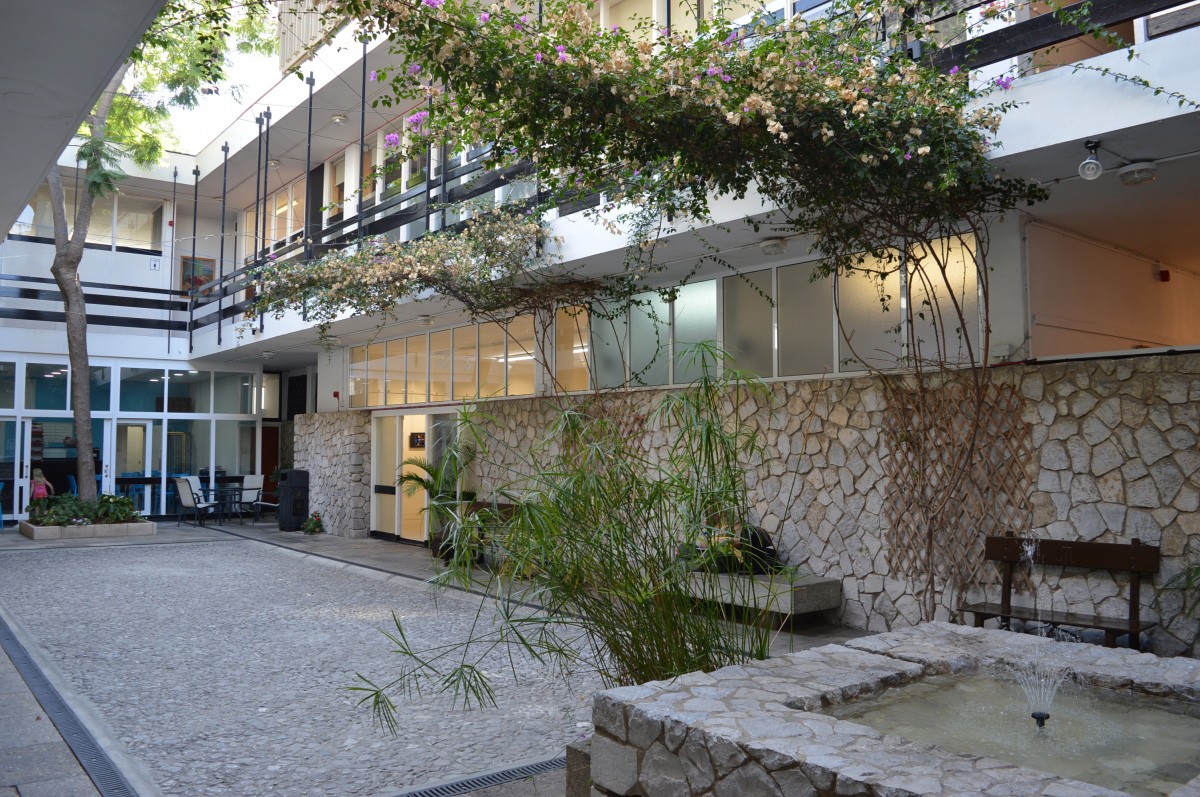
Charles V Wall, Southport Gates and Referendum Gate
Walk south and stop by the large gun at the city gates.
Charles V Wall, Southport Gates and Referendum Gate: Charles V Wall was built after 1540 when pirate Barbarossa attacked Gibraltar and sold many of their habitants into slavery. Later the wall was extended to the top of the Rock by order of Phillip II of Spain. The Southport Gates are a trio of city gates located in Charles V Wall. They are positioned between the South Bastion to the west and the Flat Bastion to the east. All three gates carry coats of arms on the outside south flank.
Southport Gate, formerly known as the Africa Gate, was the earliest gate in Charles V Wall. It was constructed by Italian engineer, Giovanni Battista Calvi, in 1552, under the reign of Charles V, Holy Roman Emperor. Southport Gate bears the Royal Arms of Charles V, Holy Roman Emperor, as well as the coat of arms of Gibraltar. Southport Ditch was a large trench which extended along the south side of Charles V Wall from the south western end of the South Bastion to Flat Bastion at Prince Edward's Gate.
The centre gate was cut through the wall in 1883. It was opened to improve flow of traffic. It was constructed during the reign of Queen Victoria and is ornamented with the coat of arms of the Governor and that of Gibraltar, over which is the Royal Arms of Queen Victoria. In the 19th century, the Southport Ditch was the site of an ordnance depot. In the 1880s, the South Bastion featured four new rifled muzzle-loading guns. A large magazine was built at Southport Ditch at that time to store the ammunition needed for the new guns. Today, this thirty ton muzzle loading gun, has been relocated inside the gates as a monument to the defence of Gibraltar by the Ordinance Department.
The third gate, named Referendum Gate, is the widest of the three gates. Also referred to as the Referendum Gate, it was carved out in 1967. The gate commemorates Gibraltar's first sovereignty referendum of 1967, in which Gibraltarians voted by an overwhelming majority to remain British rather than become Spanish. The western portion of the Southport Ditch had been utilised in the 19th century as a market garden and was known as the Sunken Gardens. At the time that the Referendum Gate was opened, that part of the ditch was filled. Trafalgar Cemetery represents a remnant of the eastern portion of the Southport Ditch, and was formerly referred to as Southport Ditch Cemetery.
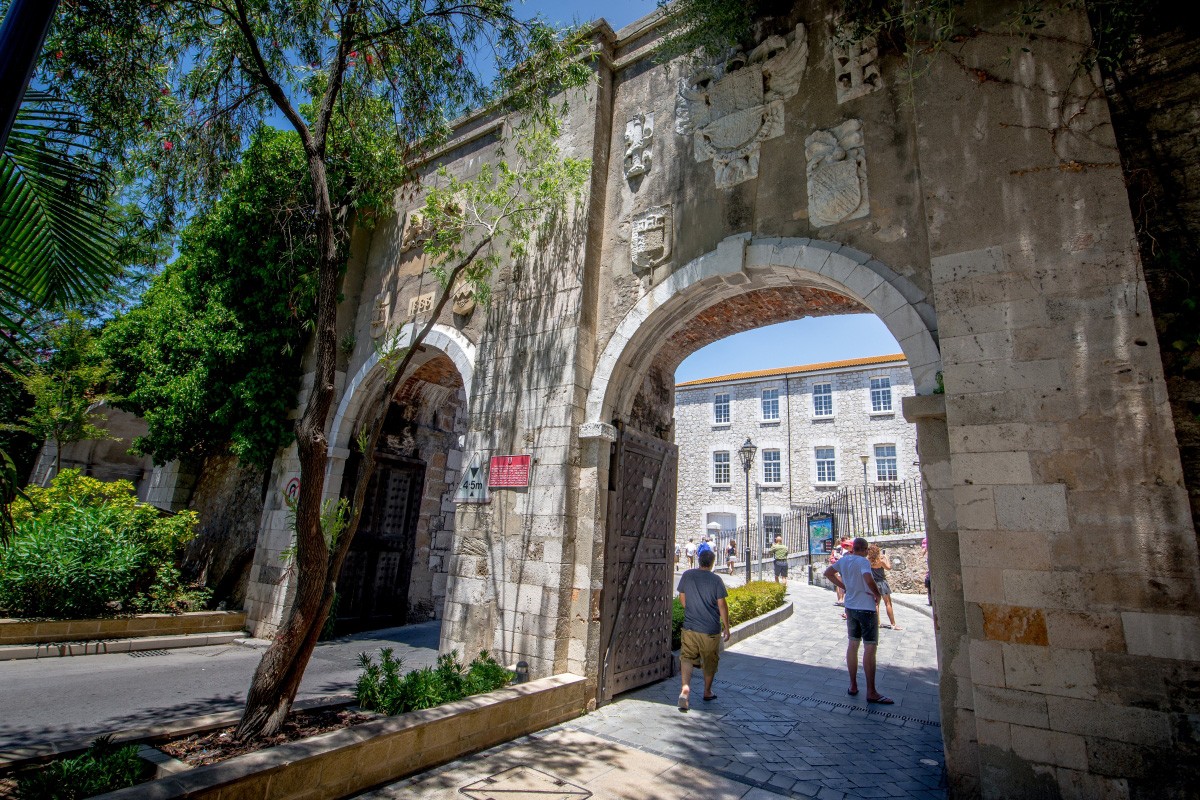
Trafalgar Cemetery
Walk through Southport Gate and stop at Trafalgar Cemetery on other side.
Trafalgar Cemetery: This is an old military cemetery, established around 1730 and consecrated in June 1798, seven years before the Battle itself. It was then known as the Southport Ditch Cemetery, and was sometimes regarded as a part of the old St. Jago’s Cemetery, which was situated at the other side of Charles V Wall.
Although the name of the cemetery commemorates the Battle of Trafalgar, only two of those who are buried here actually died of wounds suffered in the battle (Lieut. William Forster of the Royal Marine Corps of H.M.S. Mars and Lieut. Thomas Norman of H.M.S. Columbus-grave numbers 121 and 101). Most of those who died at Trafalgar were buried at sea, and Lord Nelson’s body was transported to London for a state funeral. Wounded seamen were brought to Gibraltar, and those who died later of their wounds were buried just to the north of Charles V Wall, on the opposite side of Trafalgar Cemetery, a small plaque was recently placed there to commemorate the site.
The cemetery was used for burials between 1798 and 1814, and thereafter fell into disuse, although there is one isolated tomb from 1838 near the far north-east corner (no.60 in the plan on the south wall). Earlier gravestones from St. Jago’s cemetery were set into the eastern wall in 1932, and there are also a few free-standing stones, some of which date back to the 1780s, which have been transferred over the years from the Botanic Gardens.
Many of the tombstones in the cemetery commemorate the dead of three terrible yellow fever epidemics in 1804, 1813 and 1814. Also buried here are victims of other sea battles of the Napoleonic Wars - the Battle of Algeciras (1801) and actions off Cadiz (1810) and Malaga (1812).
One tomb with an indirect connection with Trafalgar is number 103, that of John Brugier, purser of H.M.S. San Juan Nepomuceno. The San Juan Nepomuceno was originally a Spanish warship, and was one of the prizes captured at Trafalgar.
Grave numbers 46 and 47 are those of Helen Charlotte Smith and Lieut. Holloway, the Garrison Engineer, and grandchildren of Sir William Green, who as Chief Engineer of the Garrison in 1770 founded the Company of Military Artificers which later became known as the Royal Engineers.
For some years now, a ceremony has been held here on Trafalgar Day in remembrance of those who gave their lives in the great victory.
In 1992 a monument, consisting of an anchor donated by the Royal Navy and an inscription quoting Admiral Collingwood’s despatch in which he reported the victory at Trafalgar and the death of Nelson, was unveiled by the then Governor, Admiral Sir Derek Refell.
Outside Trafalgar Cemetery stands a life-size, bronze statue of Lord Nelson by British sculptor John Doubleday erected on the 200th anniversary of The Battle of Trafalgar in October 2005.
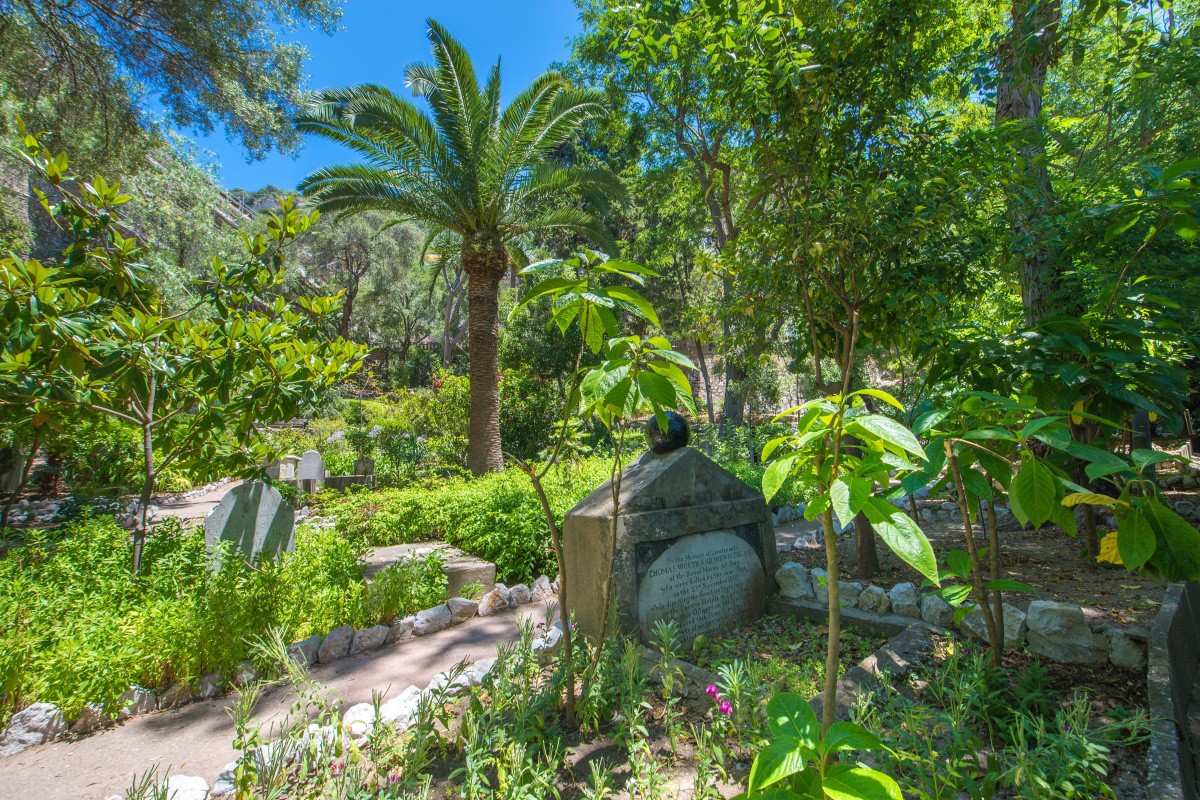



 English
English Spanish
Spanish French
French Italian
Italian German
German